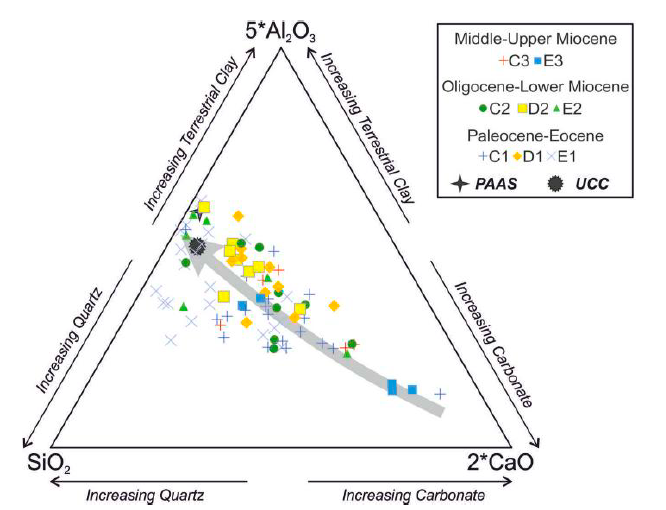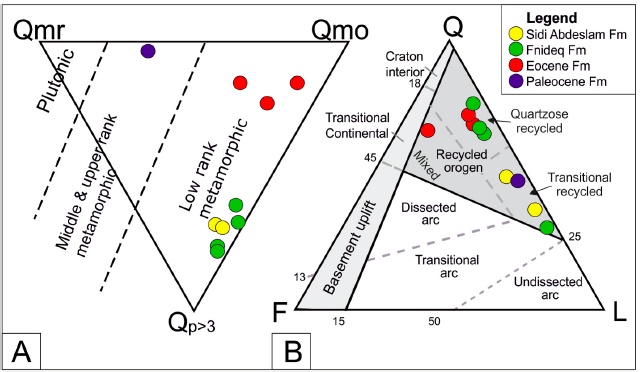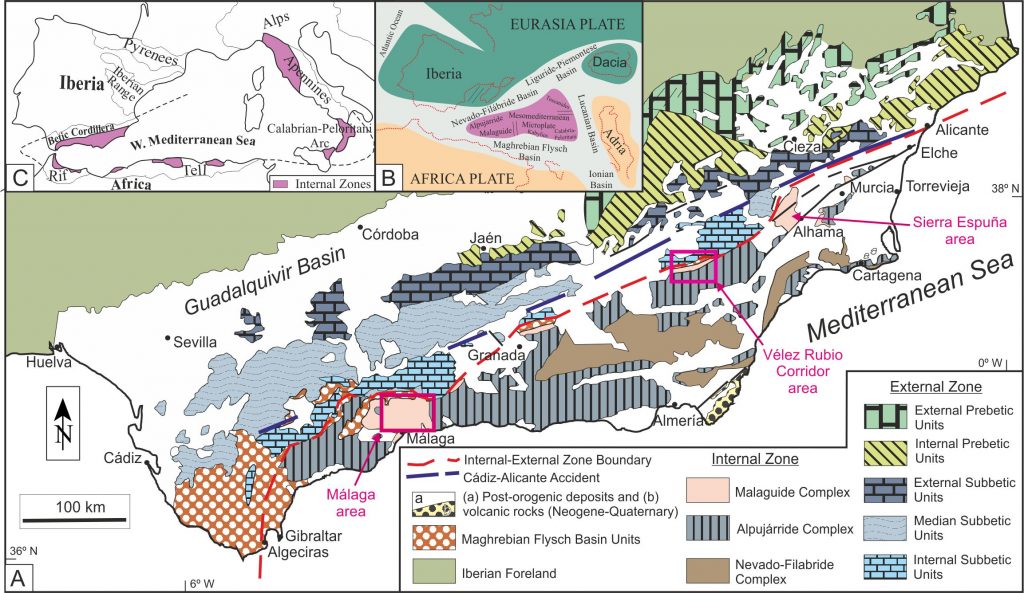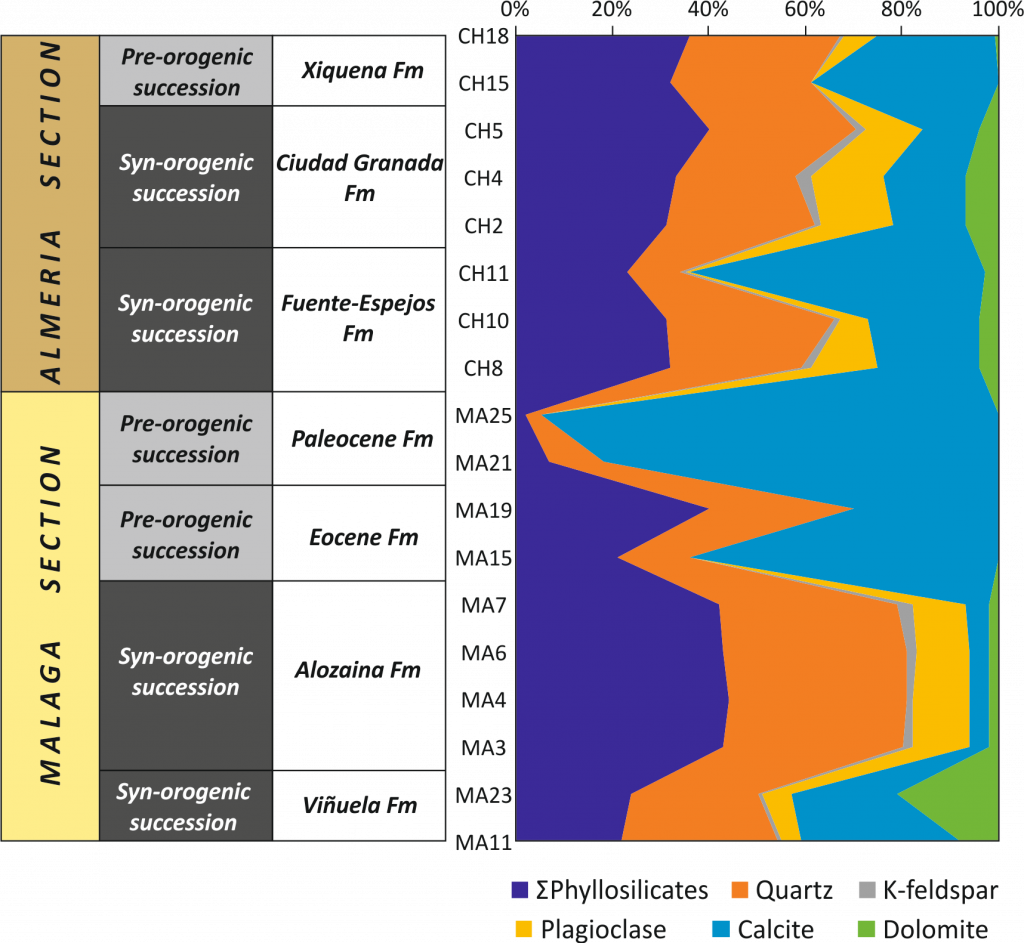Home » Posts tagged 'provenance'
Tag Archives: provenance
Cenozoic tectono-sedimentary evolution of the external rif chain (Morocco)derived from mudrocks
A model of the Cenozoic tectono-sedimentary evolution of the External Rif Chain (Morocco) is provided by means of the study of the mineralogical and geochemical composition of mudrocks. To date there was a lack of homogeneous data and of a complete and extensive study of the whole External Rif Zone (ERZ). Therefore, this work shows the study of the whole ERZ where the most representative stratigraphic sections have been selected. This work provides important information about the geodynamic evolution and the variations in source-area provenance related to the growing of the Rif orogenic belt. Although there is still much work to be done, this study aims to improve the knowledge of the Cenozoic tectono-sedimentary evolution of the entire western ERZ with a homogeneous method, with a focus on the paleogeographic and paleotectonic evolution, the paleoweathering and the source areas deduced from mineralogical and geochemical data of the Cenozoic mudrocks. The bulk mineralogy is mainly characterized by the presence of calcite, quartz and dolomite plus ankerite. Feldspars have few percentages.

Ternary diagram of SiO2-5*Al2O3-2*CaO of the studied mudrocks. UCC (Upper Continental Crust; McLennan et al., 2006) and PAAS (Post- Archaean Australian Shales; Taylor and McLennan, 1985).
The clay minerals are principally represented by mixed-layer illite/smectite (I/S). Illite and kaolinite are in little amount. Femic minerals, mixed-layer chlorite/smectite (C/S) and chlorite are the most abundant. The I/S features suggest a different thermal condition for the three domains. The chemical composition indicates that the mudrocks can be described as mixtures of carbonates with aluminosilicate components. The Al/Ti, Th/Cr, Th/Sc, La/Th and La/Sc ratios, the Cr/V vs. Y/Ni plot, the V-Ni-Th*10 and La-Th-Sc ternary diagrams indicate a predominantly felsic source with a minor mafic input more evident in the Paleocene-Eocene samples of the External Intrarif and Mesorif. The External Rif Zones changed in the Cenozoic from a passive margin to a complex foreland system with the incoming of the Alpine tectonic phases. In general, the felsic contribution should be linked to the foreland area consisting in the Middle Atlas and Mesetas massifs made of a crystalline domain. This margin probably presented an intermediate narrow oceanic branch in the External Intrarif-Mesorif boundary that surprisingly should start to close during Paleogene times providing the mafic contribution. This Paleogene tectonic activity in these domains is corroborated by the thermal maturity indicating late diagenesis. The chemical weathering indices, such as the CIA (Chemical index of Alteration) and its modifications, show medium-high values and thus suggest generally moderate paleoweathering conditions in agreement with the predominant amount of I/S.
cite as: Perri, F., Cavalcante, F., Martín-Martín, M., Sánchez-Navas, A., Alcalá, F.J., 2024. Cenozoic tectono-sedimentary evolution of the external rif chain (Morocco) derived from mineralogical and geochemical analysis of mudrocks. Mar. Pet. Geol. 170, 107124. doi: 10.1016/j.marpetgeo.2024.107124
Provenance and paleogeographic implications for the Cenozoic sedimentary cover of the Ghomaride Complex (Internal Rif Belt), Morocco
The Cenozoic sedimentary cover from the Ghomaride Complex (Internal Rif Belt) has been studied in the Tetuan area (N Morocco) where a suite of sedimentary successions from shallow-marine to deep-marine environments crops out. For that purpose stratigraphic relations and petrological and geochemical signatures have been analyzed. Sandstone suites of the overall succession are heterogeneous and testify a multi-source area, in response of accretionary processes of the Ghomaride-Malaguide units and the exhumation of the lower units of the Internal Rif Zone (e.g. Sebtide-Alpujarride Complex). Pre-orogenic and Syn-orogenic (according to the eoalpine phase) deposits have been identified consisting in two depositional sequences: lower Paleocene and Cuisian-Bartonian, and upper Oligocene-upper Aquitanian and lower Burdigalian, respectively. Pre-orogenic deposits are mainly intra-arenite and hybrid arenites made of a minor amount of siliciclastic detritus but with abundance of intrabasinal carbonate grains. The syn-orogenic sandstone suites are quartzolithic, having abundance of low-grade metamorphic and sedimentary lithic fragments. Sedimentary lithic fragments are derived from the Mesozoic successions of the Ghomaride-Malaguide Complex while metamorphic detritus is related to an unknow Internal Rif Zone basement that was exhumed starting from the late Oligocene and mainly early Miocene. Modal analyses of sandstone suites for the extrabasinal grains mainly indicate lower rank metamorphic and sedimentary source terranes of a recycled orogen. Major and trace elements coupled to the mineralogical composition of the mudrock samples indicate a provenance from felsic source area(s) with a minor but not negligible contribution from mafic rocks mainly in the syn-orogenic suites.

Geochemical analyses (Al–Ti–Zr ternary plot) indicate minor reworking and recycling processes before the final deposition through prolonged processes of sedimentary transportation. The trends evident in both CIA and CIA’ diagrams indicate source areas characterized by moderate weathering in non-steady-state conditions with a weak change of weathering condition from the pre-orogenic to the syn-orogenic cycle. Deposition during the Paleocene and Eocene, took place in the southern continental margin of the Ghomaride-Malaguide domain as a carbonate ramp. Contrarily, sedimentation in the late Oligocene-late Aquitanian took place in wedge-top basins within the Ghomaride- Malaguide domain. These changes occurred during the Burdigalian, when back arc basins were developed in the Internal Betic-Rif Zone. The Cenozoic reconstructed record was contemporaneous of the structuring of the Circum-Mediterranean chains and the Ghomaride-Malaguide Complex played a key role in the geodynamic evolution of the Rif Cordillera, representing a key tectonic element of the western Mesomediterranean domains.
Sedimentary History and Palaeogeography of the Cenozoic clastic wedges of the Malaguide Complex, Internal Betic Cordillera, Southern Spain
The Cenozoic sedimentary cover of the Malaguide Complex (Internal Betic Cordillera, Spain), in the Almería and Málaga areas, consists of a suite of sedimentary successions from continental and shallow-marine to deep-marine environments. Structural and stratigraphic relations, and petrological and geochemical signatures reveal the sedimentary evolution of the Cenozoic Malaguide Complex (CMC) from pre-orogenic (Palocene-Eocene) to syn-orogenic (Oligocene-Early Miocene) stages.

Sandstones detrital modes of the overall succession are heterogeneous testifying to a multi-source area, marked by exhumation of the Malaguide basement terranes and of the Internal Betic Zone (Alpujárride Complex) in lower position. Pre-orogenic and syn-orogenic strata consist of four main depositional sequences: the Mula Group (Paleocene), the Xiquena Group (Eocene) for the preorogenic successions; and Ciudad Granada Group (Oligocene-Aquitanian) and Viñuela Group (Burdigalian) for the synorogenic successions. Pre-orogenic strata evolve from intra-arenite to hybrid arenites to progressive increase of sandstones in abundance of detrital supply from sedimentary cover of the internal Betic units. The unroofing history of the internal Betic Units, predominantly in the Malaguide Complex, is clearly testified in strata of the synorogenic clastic units, where detrital supply is coming from the Malaguide Complex. Sedimentary lithic fragments were derived from the Mesozoic strata of the Malaguide Complex while metamorphic detritus is related to the Internal Betic Zone basement that was exhumed starting from the Oligocene. Pre-orogenic mudrocks mainly show abundance of calcite and dolomite over quartz and phyllosilicates. Syn-orogenic mudrocks, record an abrupt decrease in calcite and dolomite and an increase of phyllosilicate, quartz and feldspars mainly in the Malaga section. The geochemical signatures attest to a compositional variation of the samples from pre-to-synorogenic successions, with palaeoweathering indices showing moderate values and a weak up-section decrease. The Cenozoic Malaguide Complex played a key role in the geodynamic evolution of the Betic Cordillera, representing the key tectonic element of the western Mesomediterranean domains.

Cite as: Critelli, S., Martín-Martín, M., Capobianco, W., Perri, F., 2021. Sedimentary history and palaeogeography of the Cenozoic clastic wedges of the Malaguide Complex, Internal Betic Cordillera, southern Spain. Mar. Pet. Geol. 124, 104775. https://doi.org/https://doi.org/10.1016/j.marpetgeo.2020.104775
Recent Comments